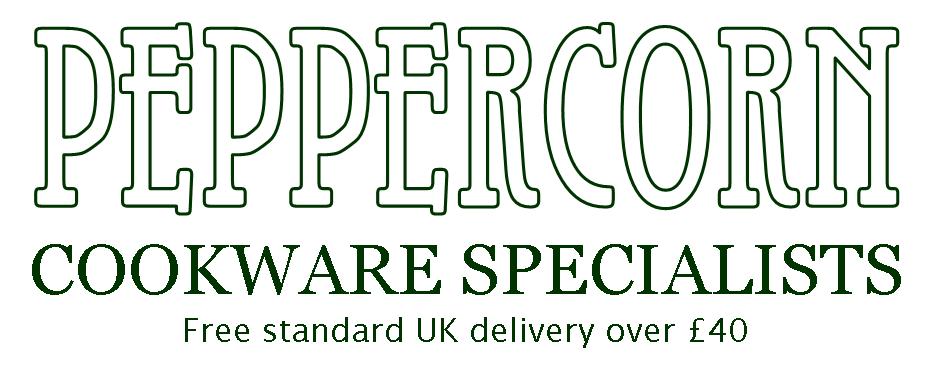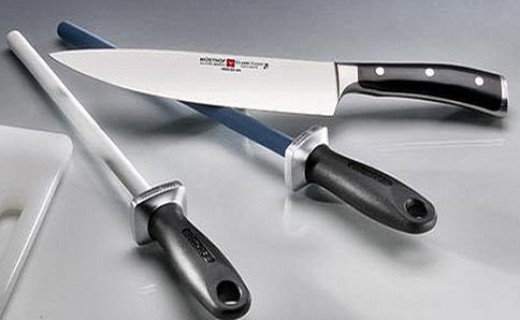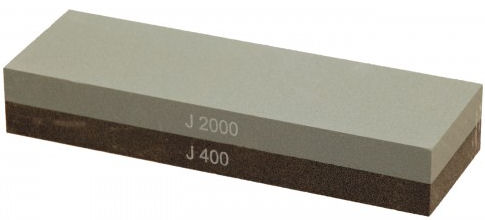Knife Sharpening
Knives should be kept sharp at all times. The key to maintaining a knife's edge is not to lose it in the first place. Letting it go blunt then sharpening it makes it harder to get the edge back on a neglected knife! A sharp, well honed knife will cut through food easily and is a pleasure to use. A blunt knife can be frustrating and it is potentially more dangerous as more force is needed and it could slip off what you are trying to cut.
Most European knives such as Wusthof are ground to an angle of 18-22º whereas Asian knives, such as Global have a finer edge at 10-15º. The different types of knives will require different sharpening processes. European knives need to be sharpened little and often, Asian knives should be sharpened less frequently but more thoroughly.
Sharpening Steels
The sharpening steel is a rod of hard steel, diamond coated steel or ceramic held in place by a handle. Steels are more suited to European style knives. The fine angle of Japanese blades makes them difficult to sharpen on a steel and in any case these knives generally incorporate a very hard steel in the blade that will not be sharpened easily by a steel.
Honing steel
This steel is coarser and more effective on a duller blade. A steel works by honing, or re-aligning the cutting edge. They are a maintenance tool and are fantastic for keeping a knife sharp but they cannot re-create an edge or rescue a very blunt knife. The coarser the steel the more it will wear the blade, while a smoother steel, or ceramic will gently hone the edge.
Diamond Knife Sharpener
The diamond sharpener is coated with up to 2,000,000 industrial diamonds. The abrasive surface allows you to create a new edge quickly and efficiently. To be used like the honing steel (shown below). Use this item to recover a blade edge. Do not use regularly in place of a honing steel.
Ceramic Sharpener
Ceramic is a very hard material. The surface of this rod is abrasive but not as abrasive as a diamond sharpener, resulting in a finer blade edge. To be used like the honing steel. Use this item to recover a blade edge. Do not use regularly in place of a honing steel.
After using a steel use a damp cloth to wipe the blade and the steel to remove any metal filings. Steels do wear eventually and need replacing if the metal has become so smooth that it has little or no effect on the knife blade. It requires a bit of practice to use a steel, if used incorrectly you can cause more harm than good and you end up with a knife that is actually more blunt! You just need to follow some basic rules.
1. The blade must be held at the correct angle to the steel. A European blade should be between 18-22º while an Asian blade should be 10-15º. See how this is done in the video below...
2. Be sure to ‘pull’ the entire blade across the steel. Pull the knife across the steel from heel to tip. Be controlled.
3. Apply even pressure. Fot the right amount of pressure imagine you are cutting a fine slice off the steel.
4. Do the same number of strokes to both sides of the blade.
Pull through sharpeners
These work like mini steels as they are designed to hone and maintain a sharp edge and yet require less practice and skill than a steel. The mini steels, diamond powder pads or ceramic wheels are set at the appropriate angle for sharpening either European or Asian blades – be sure to check you purchase the right sharpener for your knives.
To use these sharpeners simply drag the entire length of the blade through the fixed ‘V’ shaped channel. Repeat the action until the blade has been successful honed.
Sharpening Stones.
A whetstone is the preferred choice of many professionals, especially those with Asian knives, as it can form a new edge on a knife and will also hone and maintain a blade. However, like a steel, it does require a little practice and skill to use a whetstone properly – but if you want superb results it is worth learning how to use one.
Whetstones are made of ceramic or aluminium oxide - ceramic is harder wearing. The coarseness or smoothness of a whetstone is graded by a ‘grit number’. This refers to the size and number of particles that the whetstone is made of. The lower the grit number the coarser the whetstone; the higher, the smoother.
The smoothest or sharpest edge is achieved on a higher grit number.
Use the coarse side for pre-sharpening and to remove small nicks. Use the finer side of the stone for the final polishing of the edge.
How to use the Wüsthof whetstone:
- Submerge the stone in water for about 5 - 10 minutes.
- Continue to apply water while sharpening. The stone releases small particles during the sharpening process. This powder in combination with water allows the sharpening.
- Place the stone on a slip-resistant base like a towel.
- Start by using the coarse grit of the stone.
- Move the blade back and forth at an angle of 10 - 15° using gentle pressure.
- Start at the tip of the blade, continue with the middle section, and finish at the end of the blade. After a while you will notice a small burr at the edge.
- Now repeat the same process on the other side of the blade.
- Finally, turn the stone over and repeat the procedure, this time using the fine grit of the stone.
- In order to remove the remaining burr, pull the blade at an angle over the stone. Now you will have achieved the best sharpness.
- Rinse the stone and clean off the grinding residue. Clean your knife with hot water.
Please take utmost care when sharpening your knives to prevent injuries.













Leave A Comment